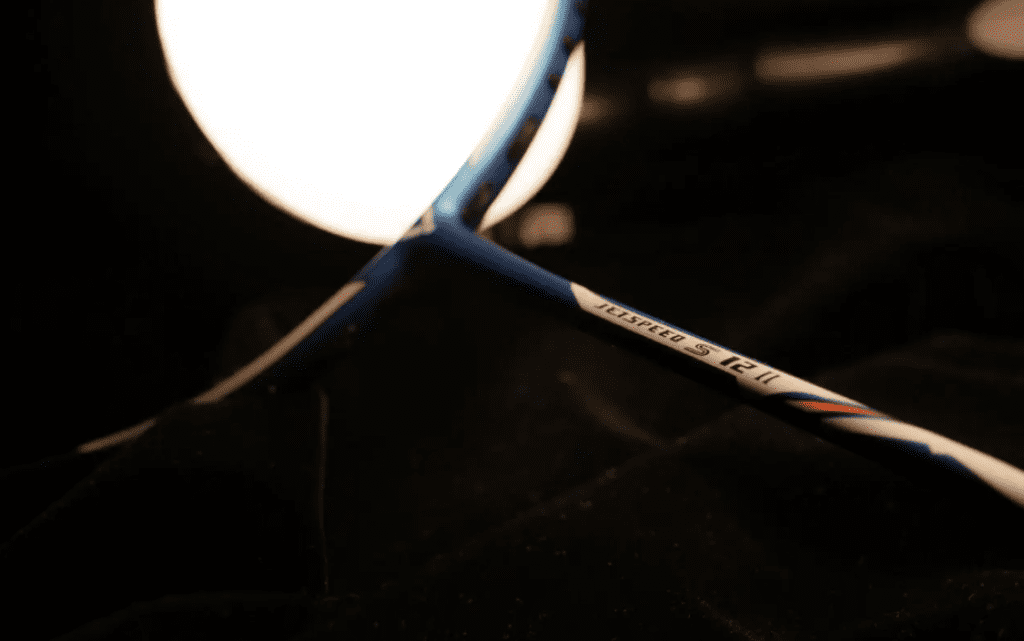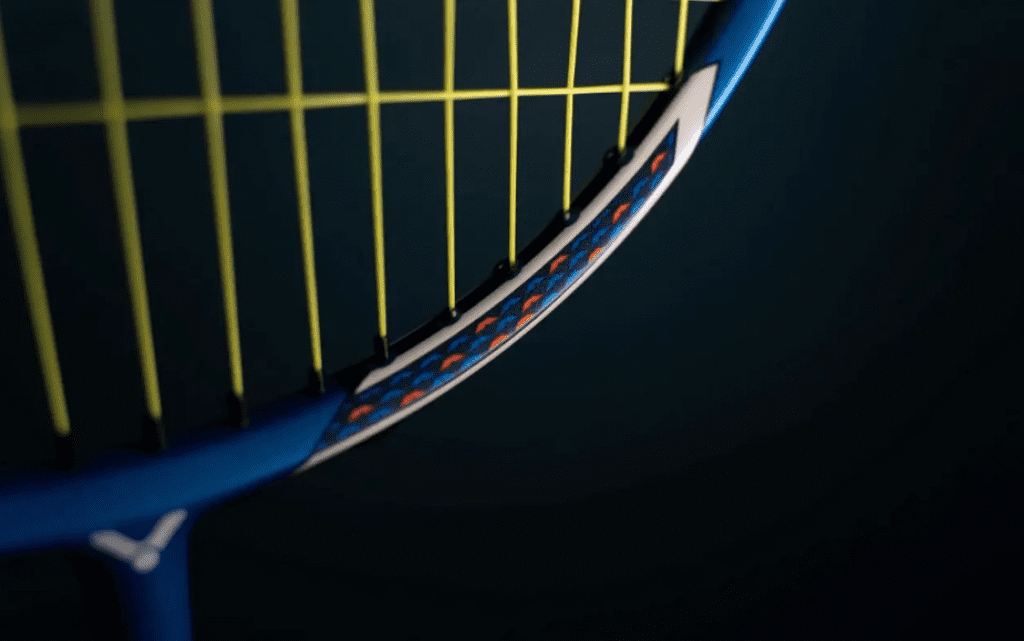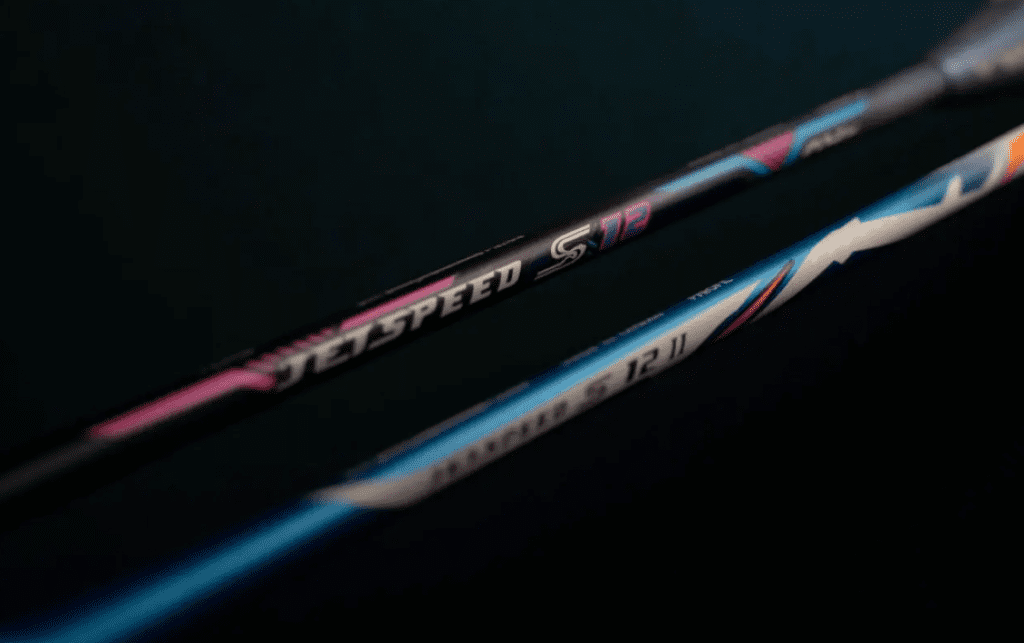Victor JS12II 4U (JETSPEED 12 Second Generation) Review
Since the release of the original Brave Sword 12, Victor has introduced the seventh high-end racket in the speed series named “12.” Unlike the Brave Sword 10 and JETSPEED 10, which are speed-oriented with an emphasis on offense, and the Brave Sword 11 and JETSPEED 11, which focus on speed with control, I believe the “12” series has always stood firmly in a balanced position, offering comprehensive speed. The first-generation JETSPEED 12 featured crisp shots, a sharp wind-breaking sound when swung, and a very well-distributed frame. Combined with a barely noticeable weight in the racket head and a large sweet spot, the first-generation JETSPEED 12 achieved near perfection for doubles play and speed-oriented rackets.

This review covers the upgraded and redesigned JS12II 4U. The JS12II builds on the original JS12, introducing a new suspension technology handle, a slimmer 6.6mm shaft (compared to the previous 6.8mm), and new molding techniques. The introduction of the suspension handle expands the possibilities for feel optimization, reduces negative feedback like vibrations, and improves product quality control. The thinner shaft represents advancements in craftsmanship and technology, and the molding improvements address the denting issues seen in the first generation.

In terms of design, the JS12II maintains the sticker style of its predecessor, with an overall color scheme closer to the original Brave Sword 12. It primarily uses white/blue/silver as the main colors, with a few red/orange stickers, resulting in a classic look. Due to the matte finish, the real-life texture is significantly better than in pictures. However, it’s unfortunate that the JS12II’s head does not use the same chameleon paint as the JS12/JS12M, though it does have a sticker on the inside of the head that changes with the viewing angle. This sticker’s position can be awkward, so it’s best to remind the stringer to use high-poundage protectors during stringing to avoid bubbles.

Regarding specs, the first-generation JETSPEED 12 was slightly heavy overall. Although I could manage the 3U version, it wasn’t particularly comfortable, so I opted for the 4U G5 specification in both the JS12M and JS12II. However, the JS12II is not as heavy as the original; the 4U version feels somewhat lighter in my hands, whereas the 4U JS12M feels just right in terms of weight. For players who seek an all-around offensive game, I recommend the 3U version. Those who choose the 4U version might consider removing the original grip and wrapping two layers of overgrip instead, as thinning the handle slightly increases the head weight sensation.

The suspension handle is made of fatigue-resistant nanomaterial nylon, which offers significant advantages over traditional wooden handles in terms of quality control, storage, and resistance to sweat erosion. As someone with sweaty hands living in a coastal city, I could only use towel grips with anti-slip powder during summer. To protect the wooden handle without taping it, I even bought shrink wrap and candles to seal it—almost worthy of a tutorial! Both the suspension handle and the carbon handle used in the earlier BXR (Boxer) series can be wrapped directly with towel grips after removing the original grip, which is a huge benefit for players with sweaty hands.

Good quality control is fundamental to high-end rackets. Synthetic materials offer higher plasticity and better quality control. Those who have disassembled the butt cap of a racket may have seen that wooden handles often have a hole (Victor typically fills this hole with a support plug). Even within the same racket model, the depth of this hole can vary—some are deep, some shallow, and some filled with material. These holes ensure the wooden handle has a consistent weight, ensuring uniform balance parameters across the same model, requiring manual adjustments. The grain and cutting direction of wood directly affect the handle’s strength, necessitating extra effort for quality control. However, the inherent flaws of wooden handles are increasingly unable to keep up with the technological demands of major manufacturers.

The suspension handle material used in the JS12II is more resilient, reducing stress concentration at the shaft-handle junction. This allows for a noticeable increase in shaft flex compared to the first generation. A longer shaft generally translates to a greater swing range and better leverage. For doubles, this makes higher grip flat drives more agile. The introduction of the suspension handle resolves the contradiction between long shafts and long handles in doubles rackets. Although the JS12II is a long-handle short-shaft doubles racket, its swing range and flexibility are very similar to those of a short-handle long-shaft racket.
However, I find the grip on the JS12II to be too soft and not as direct. Removing the grip and adding two layers of GR233 makes it feel much more satisfying.

Regarding string pairing, I suggest using high-hardness or crisp-sounding strings. The VBS66nano and VBS68 are both excellent choices. For 4U specifications, I recommend a tension of ≤29 lbs. Given that the JS12 is already a crisp-hitting speed racket, I suggest not stringing it below 24 lbs, as lower tension could affect the experience with the racket and strings. Personally, I prefer GR233 and GR262 for grips, while towel grip users should consider pairing it with the ultra-thin towel grip GR334 (can we get a bulk roll already~~~).

JETSPEED 12II vs. Brave Sword 12 (Part 1)
Comparing the JETSPEED 12II to the Brave Sword 12 feels a bit unfair, as there’s nearly a decade between their releases. Ten years ago, racket quality was judged on whether it had grommet jumps, sticker burrs/wrinkles/print shadows, bubbles in the paint, or poor paint adhesion. At that time, the Brave Sword 12 often had burrs inside the frame due to the masking process, and the paint adhesion was poor, making it prone to chipping. By the time of the JETSPEED 12II, paint chipping from shuttlecock impact had been resolved, and the science of color had advanced enough to bring in enough talent and technology. (Shout out to the guy living above me.) The workmanship has evolved significantly since then.

JETSPEED 12II vs. Brave Sword 12 (Part 2)
In terms of feel, the JS12II truly secures its place as the king of comprehensive speed. While the JS12 first-generation leaned more towards offense, with elasticity, stability, and power feedback all surpassing the Brave Sword 12, it did lose out in agility due to its slightly heavier weight. The JS12II, on the other hand, solidifies its position as a balanced speed racket, with balance parameters very close to the Brave Sword 12. Its more refined frame (slightly tapered at the lower frame) and shaft make it more agile than the Brave Sword 12. Some may argue that the JETSPEED 10 is faster and more agile, but the JETSPEED 12II offers a much larger sweet spot, which is a definite advantage in fast-paced exchanges.

JETSPEED 12II vs. JETSPEED 12M (Part 1)
Honestly, the JS12M’s design is more advanced than the JS12II. The blue on the JS12M’s head changes with the angle of the light, and the green at the 2 o’clock position of the frame adds a sense of mystery. The bold pink stickers are simply a strong man’s favorite. The JS12II pales in comparison, though its design still pays homage, resembling both the Brave Sword 12 and the Super Wave 37 (if you’ve seen it, you’re as old as I am—haha).
Aside from the design, the JS12M feels like a younger brother compared to the JS12II. In terms of materials and craftsmanship, the second generation is significantly improved. Even just the 6.6mm shaft outshines the previous 6.8mm one.

JETSPEED 12II vs. JETSPEED 12M (Part 2)
In terms of physical properties, the JS12M head is slightly heavier than the JS12II, even in the same 4U specification. This results in the first generation being more aggressive, while the second generation is more agile. The first generation is like a long, sharp goose-quill saber, while the second is more like a swift, invisible sword. In terms of attack, the first generation has a slight edge in smashes. This isn’t to say that the second generation lacks offensive capabilities, but the first generation’s slightly heavier weight makes it better for smashing. I even preferred the JS12F, which leans more towards women, for a time. The second generation has a more moderate overall weight, making it better for quick kills and net rushes. Unfortunately, the JS12II doesn’t incorporate the whipping sensation of the JETSPEED 90S, which would have made it a truly legendary racket.

Conclusion
Compared to the first generation’s offensive focus, the JETSPEED 12II is more versatile. The 4U version has obvious advantages in defense and flat drives, with the cellulose fiber-reinforced shaft offering excellent elasticity. The new handle increases shaft flex and makes the racket easier to leverage. This all makes the JS12II more user-friendly than the first generation and better at breaking out of defensive situations. However, if you particularly enjoy the satisfaction of smashing in doubles, I’d still recommend the JS12M or the 3U JS12II. The 4U JS12II is more focused on agility and speed, so don’t expect too much from it in terms of offense. The suspension handle brings the long

Leave a Reply